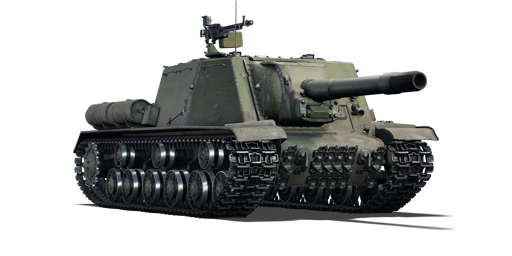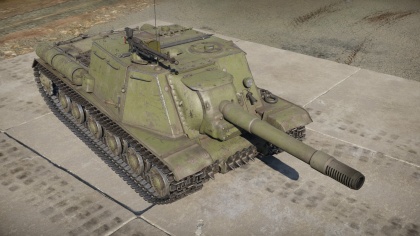ISU-152
Contents
Description
The ISU-152 is a rank III Russian tank destroyer
with a battle rating of 4.7 (AB/RB/SB). It was introduced during the Closed Beta Test for Ground Forces before Update 1.41. Wielding the same infamous 152 mm gun as on the SU-152, the ISU-152 presents better armour, mobility, and firepower with the addition of the heavy-hitting HEAT round for the gun.
General info
Survivability and armour
Armour type:
- Rolled homogeneous armour
- Cast homogeneous armour (Gun mantlet)
| Armour | Front | Sides | Rear | Roof |
|---|---|---|---|---|
| Hull | 60 mm (75°) Front glacis 90 mm (31°) Lower glacis |
90 mm | 60 mm (50°) Top 60 mm (39°) Bottom |
30 mm |
| Superstructure | 90 mm (29°) Front glacis 65 mm (7-69°) Gun mantlet case 100 mm Gun mantlet (0-45°) |
75 mm (14-15°) | 60 mm (1°) | 30 mm |
Notes:
- Suspension wheels are 20 mm thick while tracks are 30 mm thick.
Mobility
Write about the mobility of the ground vehicle. Estimate the specific power and manoeuvrability, as well as the maximum speed forwards and backwards.
Armaments
Main armament
Give the reader information about the characteristics of the main gun. Assess its effectiveness in a battle based on the reloading speed, ballistics and the power of shells. Do not forget about the flexibility of the fire, that is how quickly the cannon can be aimed at the target, open fire on it and aim at another enemy. Add a link to the main article on the gun: {{main|Name of the weapon}}. Describe in general terms the ammunition available for the main gun. Give advice on how to use them and how to fill the ammunition storage.
Machine guns
Offensive and anti-aircraft machine guns not only allow you to fight some aircraft but also are effective against lightly armoured vehicles. Evaluate machine guns and give recommendations on its use.
Usage in battles
Describe the tactics of playing in the vehicle, the features of using vehicles in the team and advice on tactics. Refrain from creating a "guide" - do not impose a single point of view but instead give the reader food for thought. Describe the most dangerous enemies and give recommendations on fighting them. If necessary, note the specifics of the game in different modes (AB, RB, SB).
Pros and cons
Pros:
- Great calliber provides enourmous damage output
- Powerful HEAT ammo with good HE blast
- Fast reload for the caliber
Cons:
- Armour cannot stand up against high rank cannons
- Small crew compartment
- Armour not angled
- Rather sluggish
- Very inadequate gun depression of -3°
- Gun breech often gets damaged while under enemy fire
History
Development
Development of the ISU-152 already started alongside the SU-152, its predecessor. The SU-152 was based off the KV-1S tank, which itself is a lighter version of the KV-1 heavy tank. The vehicle, while highly praised in its performance, saw a need for modernization with the KV-1's phasing out of the Soviet's inventory and being replaced with the new IS heavy tanks. The modernization process began on May 25, 1943 with the goal of using the IS tank as the basis of the vehicle and also increasing armour protection alongside other improvements. Development began in July under Joseph Yakovlevich Kotin, a chief designer of Soviet heavy tanks, who worked alongside G. N. Moskvin as the main designer. The designing of the improved vehicle went on for a month before the first variant was ready, designated the IS-152. This was tested in September 1943, which revealed defects and deficiencies with the design, so it was redone into a second variant called Object 241 in October 1943. Trials began on Object 241, which was successful through factory and state trials and adopted on November 6, 1943 as the ISU-152. Production began in December at the Chelyabinsk Kirovsk Plant, producing 3,242 units from then all the way until the 1947, with 1,885 units made by the end of World War II.
Design
The ISU-152 was the successor to the SU-152, retaining the same 152 mm ML-20S howitzer needed to destroy enemy fortifications in offensive operations. The vehicle was run on a torsion-bar suspension system from the IS tank chassis. The crew consists of four or five men in the vehicle, the optional crew member being a loader. The crew had external views through periscopes and two gun sights, a panoramic and a telescopic one. Crew communication was possible with an intercom system and a 10R or 10RK radio was available to communicate between vehicles. The crew had access to two PPSh submachine guns and grenades in the tank to defend themselves against infantry.
A drawback to the vehicle's design was the gun ammunition and internal stowage. The large ammunition pieces were limited to about 20 rounds in the vehicle, and each rounds were extremely heavy and large that reloading the tank can take up to 40 minutes and lots of strength. Rate of fire was also reduced by the ammunition's heavy weight.
Combat usage
The ISU-152 was issued in a similar manner to the SU-152 in independent Heavy Self-propelled Artillery Regiments. Each regiments, of which 53 were formed from May 1943 to 1945, had 21 guns divided into four batteries of five vehicles and a commander vehicle. These regiments were supported by other military units to be flexible against threats. In December 1944, the Guards Heavy Self-propelled Artillery Brigades were formed to provide heavy fire support. These brigades had up to 65 vehicles, which would consist of ISU-152s or ISU-122s.
Like its predecessor the SU-152, the ISU-152 also served as a multi-role vehicle as a heavy assault gun, tank destroyer, and self-propelled artillery. As an assault gun, the vehicle was valuable during the Soviet's offensive operations assaulting fortified cities held by the Axis forces. The 152 mm gun was very successful in demolishing fortifications and strong points. The greater armour protection on the ISU-152 compared to the SU-152 (90 mm vs. 65 mm) made the vehicle very durable against German anti-tank weapons, even forcing the Tiger to come withing close range to penetrate the vehicle. Usual tactics of the ISU-152s in urban combat was to act in one or two vehicle groups with infantry to deter infantry anti-tank weaponry like the Panzerfaust. As a tank destroyer, the ISU-152 worked its unintended role well enough that it inherited the nickname Zveroboy ("Beast Killer") from the SU-152s. The ISU-152 was very capable of destroying many of the more armoured German tanks like the Panthers, Tiger Is, and Tiger IIs. Though not as rapid-firing or as accurate as dedicated anti-tank guns, the rounds of the 152 mm howitzer could blow the turret off a Tiger tank, and a direct hit would definitely caused extensive internal damages to the tank's internal mechanisms or kill the crew due to spalling of the hull due to the explosive force. The tank destroyer role was phased out with the introduction of dedicated vehicles like the SU-100. As a self-propelled artillery piece, the ISU-152 is able to successfully fire in indirect bombardments against enemy targets up to 7,000 meters away. Though it was not really a specialized vehicle for the role, it was better than typical towed artillery pieces due to being able to move and being an enclosed vehicle to protect the crew. The ISU-152 served in all these roles in all of the Soviet offensive operations into German territory all the way until the Battle of Berlin.
Many ISU-152s were exported by the Soviets after World War II to assist its allies and other Warsaw Pact members. Countries that had access to the ISU-152 in their military were Finland, Poland, China, Czechoslovakia, North Korea, Egypt, Iraq, Yugoslavia, and Romania. All of which used the ISU-152s up until the 1970s at latest.
Media
Skin and Camouflages for the ISU-152 in Warthunder Live.
See also
Links to the articles on the War Thunder Wiki that you think will be useful for the reader, for example:
- reference to the series of the vehicles;
- links to approximate analogues of other nations and research trees.
External links
| USSR tank destroyers | |
|---|---|
| SU-76M | SU-76M · SU-76M (5th Gv.Kav.Corps) · SU-85A |
| SU-57B | SU-57B · SU-76D |
| T-34 Derivatives | SU-122 · SU-85 · SU-85M · SU-100 · SU-122P |
| Heavy Tank Derivatives | SU-100Y · ISU-122 · ISU-122S · SU-152 · ISU-152 · Object 268 |
| SU-100P and Derivatives | SU-100P · Object 120 |
| Wheeled | YaG-10 (29-K) |
| Airborne | ASU-57 · ASU-85 |
| Rocket | BM-8-24 · BM-13N · BM-31-12 |
| ATGM | IT-1 · Shturm-S · Object 775 · Khrizantema-S |
| Artillery | 2S1 · 2S3M |
| Other | SU-5-1 · ZiS-30 · SU-122-54 |
| USA | SU-57 |





